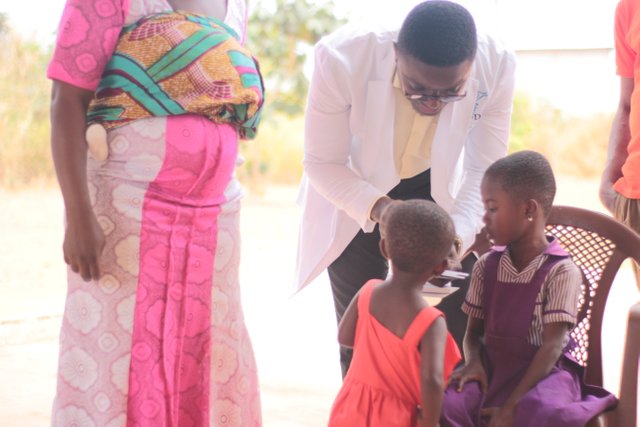Retinitis Pigmentosa is a group of diseases that are mostly obtain through our genetic make-up in other words inherited. The disease mostly affect the the cells in the eyes that transduce or convert light energy into electrical impulses for interpretation by the brain. These are known as photoreceptors, there are two type those that are mostly active during the day known as cones and those that are active at night or in dim light known as rods. Retinitis pigmentosa tends to involves the rods more than the cones because of this the condition is also known as rod-cone dystrophy. In most of the cases of Retinitis Pigmentosa , there is a primary degeneration of the photoreceptor rods, with secondary degeneration of cones. The condition is not caused by injury, infection or environmental factors. The condition is also associated with 32 variety of genes of which control different traits which may be inherited in a number of ways.
Etiology
Most mutations affect rods selectively and, through an unknown pathway, cause apoptotic death of the rod cells (clinically leading to night blindness and substantial defects in the peripheral visual field). Cones are seldom directly affected by the identified mutations, but in many cases they degenerate secondarily to rods (clinically leading to visual field constriction, loss of central vision and complete blindness). Retinitis Pigmentosa usually starts in childhood or adolescence. But exactly when it starts and how quickly it gets worse varies from person to person.
Signs and Symptoms
Most people with RP lose much of their sight by early adulthood. Then by age 40, they are often legally blind. Because rods are usually affected first, the first symptom you may notice is that it takes longer to adjust to darkness (night blindness). In children, parents may comment that their child is afraid or becomes distressed in the dark. Older children often comment on poor vision compared with their fully sighted peers. In adults , difficulties with night driving are frequent. The second cardinal symptom of RP is progressive peripheral visual-field loss. Since central vision is spared early in the course of the disease, some patients do not notice this loss of visual field until the degeneration has become quite advanced. In later stages, your cones may be affected. That will make it harder for you to do detail work, and you may have trouble seeing colors. It’s rare, but sometimes the cones die first. Because there are many gene mutations that cause the disorder, its progression can differ greatly from person to person. You might find bright lights uncomfortable, a symptom called Photophobia. You also may start to see flashes of light that shimmer or blink. This is called Photopsia. Patients with cone and cone-rod dystrophies can present with early photophobia, decreased central vision and impaired color vision. These patients will typically have worse visual acuity than patients with rod-cone dystrophies due to earlier involvement of macular cones.
Epidemiology
Retinitis Pigmentosa is the leading cause of inherited blindness with approximately 1/4,000 individuals experiencing the non-syndromic form of their disease within their lifetime. It is estimated that 1.5 million people worldwide are currently affected. Early onset RP occurs within the first few years of life and is typically associated with syndromic disease forms, while late onset RP emerges from early to mid-adulthood.
Diagnosis
Retinitis Pigmentosa is diagnosed via Ophthalmoscopy, Electroretinogram(ERG),Visual field testing ,Dark adaptation test, Fluorescien angiography,Optical Coherance tomography and genetic subtyping.
Treatment
Currently, there is no known cure for most forms of RP ,although some treatments have been shown to slow down the progression of the disease and future therapies are promising.
- Treatable Forms of RP
A few rear forms of RP are amenable to specific treatments. It is important to rule out these treatable forms of RP because prompt therapy can prevent further damage .The treatable forms of RP include adult Refsum disease. - Resource/support for patients with RP
The diagnosis of RP can be both frightening and confusing to patients.In addition to having their questions answered by physician,patients can benefit by meeting with a genetic counselor who can take a detailed family history and answer questions about hereditability. - A few options can slow your vision loss and may even restore some sight:
• Acetazolamide: In the later stages, the tiny area at the center of your retina can swell. This is called macular edema, and it, too, can reduce your vision. This medication can ease swelling and improve your vision.
• Vitamin A palmitate: High doses of this compound may slow retinitis pigmentosa a little each year. But you have to be careful, because too much can be toxic. Work closely with your doctor and follow her recommendations.
• Sunglasses: These make your eyes less sensitive to light and protect your eyes from harmful ultraviolet rays that may speed vision loss.
• Retinal implant: If you have late-stage RP, you may be a candidate a retinal implant that could provide partial sight. Argus II is the implant available in the US. It’s implanted into a single eye and paired with glasses equipped with a camera. Images are converted to electrical pulses that are sent to the retina.
Other treatments under review include:
• Replacement of damaged cells or tissues with healthy ones
• Gene therapy to put healthy genes into the retina
REFERENCES
Weleber, R .G and Gregory-Evans k(2006).Retinitis pigmentosa and allied disorders. In;Ryan,S. J (ed).The Retina 395-498.
AAO(2019) American Academy of Ophthalmology, Retinitis Pigmentosa Diagnosis and Treatment – Limited Revision, San Francisco,CA.
Fishman ,G. A,Farber,M. D and Derlacki,D. J (1988) X-linked retinitis pigmentosa ,Profile of clinical findings, Archives of Ophthalmology 106; 369-375
Beshare,C J and |Bok D(2011) The Retina and its Disorders,1st edn,USA,Academic Press,Page 698-707.

What is @bettervision about?
@bettervision is is a project initiated by @nattybongo and friends to give back to the society the knowledge and skill acquired through the Optometric Studies in Kwame Nkrumah University of Science and Technology, Ghana.It is an outreach system where we visit the less privileged communities to offer free eye screening services and education to the people within the community
AIMS AND OBJECTIVES
To reduce or prevent vision loss through diseases such as glaucoma, cataract and refractive errors.
To enlighten the majority of the Ghanaian population about the importance of proper visual care.
To conscientize people on the need for regular eye checks
To get more people to have their wards screened within the Critical periods of a Child’s Vision Development; thus from ages 3 to till about 10 years.
To help the blind and people with low vision live a better life within the society through education of the general public to stop stigmatization.
To help in the fight of extreme poverty that puts the health of people at risk

Our greatest gratitude goes to @fundition @scoop-stakes, @ackza, @adollaraday, @girlsfoundation, @mcsamm, @anamang, @steemitashanti @surfyogi @bleepcoin @ackza @indigoocean @nanzo-scoop @steemstem @demotruk @pennsif @steem-ambassador @kasho and @wafrica. for helping to make the aims and objectives of @bettervision a reality.









Hello! I find your post valuable for the wafrica community! Thanks for the great post! We encourage and support quality contents and projects from the West African region.
Do you have a suggestion, concern or want to appear as a guest author on WAfrica, join our discord server and discuss with a member of our curation team.
Don't forget to join us every Sunday by 20:30GMT for our Sunday WAFRO party on our discord channel. Thank you.
Downvoting a post can decrease pending rewards and make it less visible. Common reasons:
Submit